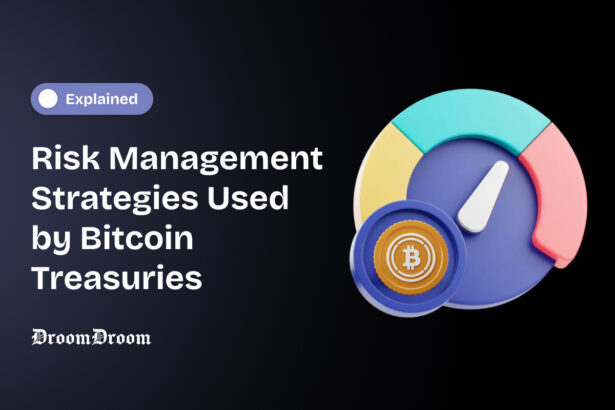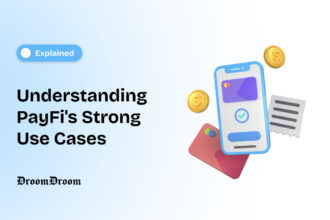Since the adoption of Bitcoin in corporate funds, ETFs, and Treasuries, a lot of ways have emerged to better manage the risk associated with it. Much of the risk arises due to the volatile nature of cryptocurrencies. However, there are risks emerging from other sectors like crime and regulations too.
In this article, we will explore the risk management strategies that define the way Bitcoin Treasuries handle this unique asset. By the end of the article, our readers will be able to delineate the differences and probably learn better ways of managing their Bitcoin portfolios.
What is Risk Management?
Risk Management or better termed as Risk Mitigation is the way Bitcoin Treasuries (or any financial firm) minimizes the risks and threats associated with Bitcoin (or any other asset).
These strategies include operations against price volatility, security threats and government regulations.
Risks of Bitcoin Treasuries
Bitcoin Treasuries are vulnerable to various threats and risks be it from price volatility or organized cyber crime. We have mentioned a few of them below.
10 Factors to Consider for Companies Before Building Their Bitcoin Treasuries
Price Risk
Bitcoin’s first and most significant risk is around its price. The price of 1 Bitcoin has varied so greatly in the past that within a period of 1 year, ie., between January 2024 and December 2024, it shot up from $15,800 to $106,000.
A similar trend was also seen during the 2022 and 2023 bear markets when the price fell from $70,000 to $16,000 in little over a year.
Security Risk
Bitcoin has a lot of risk emerging from hacks, especially after notable hacks like Mt. Gox (750k BTC lost) and LuBian (127.5k BTC lost). These hacks emerge from sophisticated criminal or criminal networks and have the potential to compromise even the best security apparatus.
Risk Offset Strategies
Each kind of risk is managed in its own way, which makes risk mitigation a very specialized work. Price volatility is seldom anticipated in any financial asset. Further, after each hack, hackers often change their ways due to increased security.
Therefore, each risk needs to be mitigated through the best known route.
Short Selling via Spot
Short selling is the oldest way of risk management where a borrowed asset is sold at a certain price but payment is deferred. In the future, if the price crashes, the asset is repurchased at a cheaper price and returned to the original lender.
This method only works well where price volatility can be anticipated in advance such as elections.
Short selling via spot markets is the basis of creation of the derivatives markets.
Below is an example of a short seller in action.
Hedging with Futures
Futures listed on top exchanges like CME, Derebit, Binance, and other platforms are used to hedge price volatility risk in Bitcoin Treasuries.
In this method, an equal amount of Bitcoin as available in the treasury is sold via futures. If the price of Bitcoin crashes, the future trade gains in a proportionate amount, and if the price rallies, the futures contracts lose an equal amount of money. As a result, the net effect on the value of Bitcoins is zero.
This strategy is used to deal with uncertain situations where there is a possibility of a significant rally or a significant crash.
What is a Bitcoin Futures ETF? How Does it Work? List of 16 Top Bitcoin Futures ETF
Hedging with Options
Options hedging is similar to futures hedging except the cost of buying and selling options are much cheaper than those in the futures. This method is a bit more complex due to the availability of 4 methods to trade Bitcoin as opposed to 2 in futures (buy and sell).
In options, the user (Treasury Manager) can short Bitcoin either by selling calls or buying puts and go long in Bitcoin by selling puts and buying calls. Buying options is a lot cheaper than selling but has greater risk of getting liquidated.
Cost Averaging
Cost Averaging as a risk management strategy is employed when after the initial purchase of Bitcoin, the price falls further. Opposed to earlier mentioned strategies, it is a post-event method of minimizing risk (not eliminating)
Here, further purchases are made as long as the price of Bitcoin remains in bearish trend. When the price returns to bullish trend, the treasury becomes profitable much before than what had been the original case.
Strategy (MicroStrategy of Michael Saylor) employs this method to buy Bitcoins when they are relatively cheaper. As a result, their average purchase price is much lower than their peers.
Security Risk Management
Security Risk is managed by insuring Bitcoins at a regulated insurance provider. Typically, the insurance premium for securing assets is at 0.5% of the total insured value.
However, considering the risk of handling Bitcoins, the insurer may charge some extra over the 0.5% mark.
Top Bitcoin insurance providers include CoinCover, BitGo, Nexus Mutual, etc.
Custodial Risk Management
Custodial Risk emerges due to a direct threat to several crypto custodians, many of whom are centralized exchanges. This threat has alleviated due to the $1.4 billion hack of the Bybit Exchange.
Hackers employ advanced tactics like hacking the UI of the wallet, which then tricks the users into believing that the transfer is a routine one.
This kind of risk is managed by using multiple wallets and employing multi-signature wallets to store private keys.
The Evolution of Centralized Crypto Exchanges: Strong Hurdles and the Path Ahead
Stakeholder Education
Stakeholder education is the most important aspect of ensuring the safety of Bitcoin Treasuries. Stakeholders include everyone who works for the treasury or is a beneficial owner of it.
Oftentimes, IDs of low level employees are stolen and cloned to get access to the custodian’s or treasury’s server.
Another common tactic employed by hackers is voice modulation to mimic the voice commands of a senior employee or executive.
Whatever be the case, awareness campaigns on risk management plays a far more important role in ensuring the security of Bitcoin Treasuries. Employees need sensitivity training in understanding their role in ensuring the security of the treasury, so that there is a multi-layered security available at all times.
Are Bitcoin Treasuries Heading Towards a Bubble like the Dot Com or Housing Crisis?



















